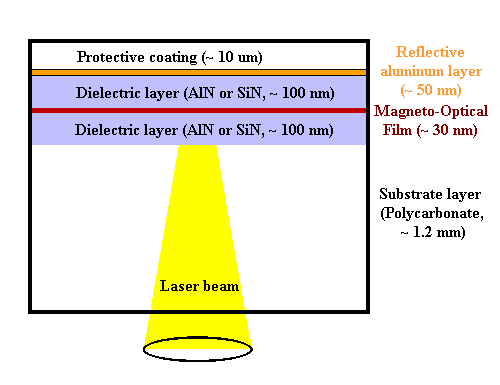
Magneto-optical (MO) storage combines two technologies to give a storage medium that has high data densities, durability, and quick data transfers. MO drives write magnetically (with thermal assist) and read optically.
Magnet materials have a physical property
called a Curie temperature above which they lose magnetization due to the
complete disordering of their magnetic domains. The magnet's coercivity,
which is its resistance to magnetization by an outside magnetic force,
decreases as the the temperature approaches the Curie point, and is zero
thereafter. To record data in a magneto optical device, a laser
heats up the media, decreasing the media's coercivity to a level that allows
its magnetism to be modified by a relatively weak magnetic field.
Once the data is written, the area then cools, and the magnetic data is
not subject to modification or erasure by magnetic forces encountered during
our daily routine.
 |
To read the data from the MO media, the
drive not not use magnetic current induced in the heads by the changing
magnetic flux on the disk, as a hard drive does, but instead takes advantage
of the Kerr effect. Because of the Kerr effect, the polarization
of light will change when it is shined upon an area of the disk that is
magnetized. Shining a beam of polarized light on a magnetized surface causes
the polarization of the light to shift slightly (usually less than 0.5o).
If the magnetization is reversed, then the angle of change in polarization
(the Kerr angle) is changed as well. The change in direction of magnetization
can be viewed as ones and zeros, making MO convenient for data storage.
 |
As can be seen, the structure of MO media is in some ways similar to that of CD-RW media. But instead of changing the refractivity of the media when it is heated, an MO drive changed the magnetic flux of a small area of the disk.